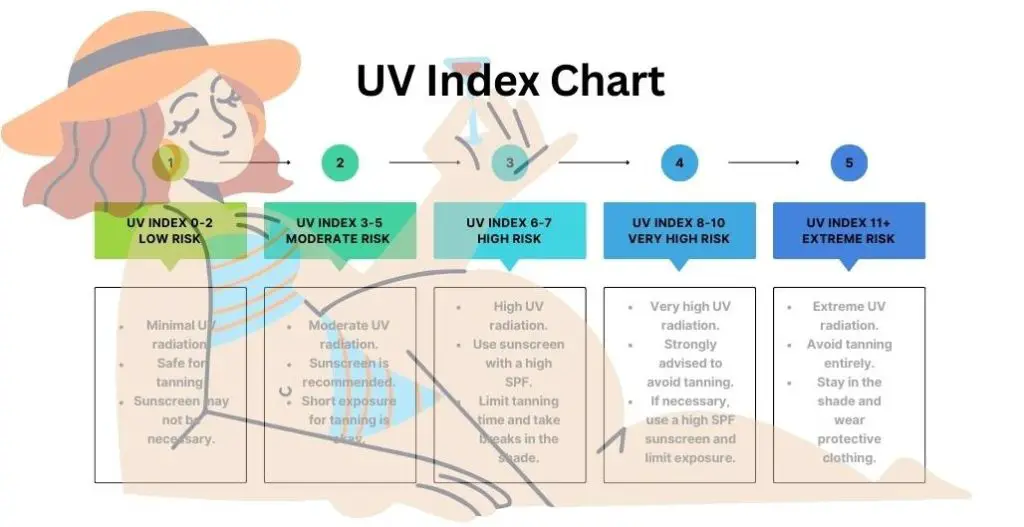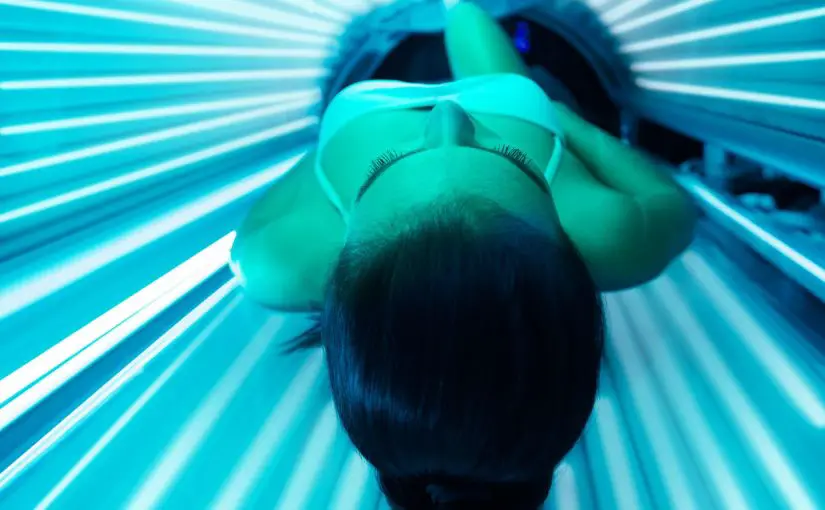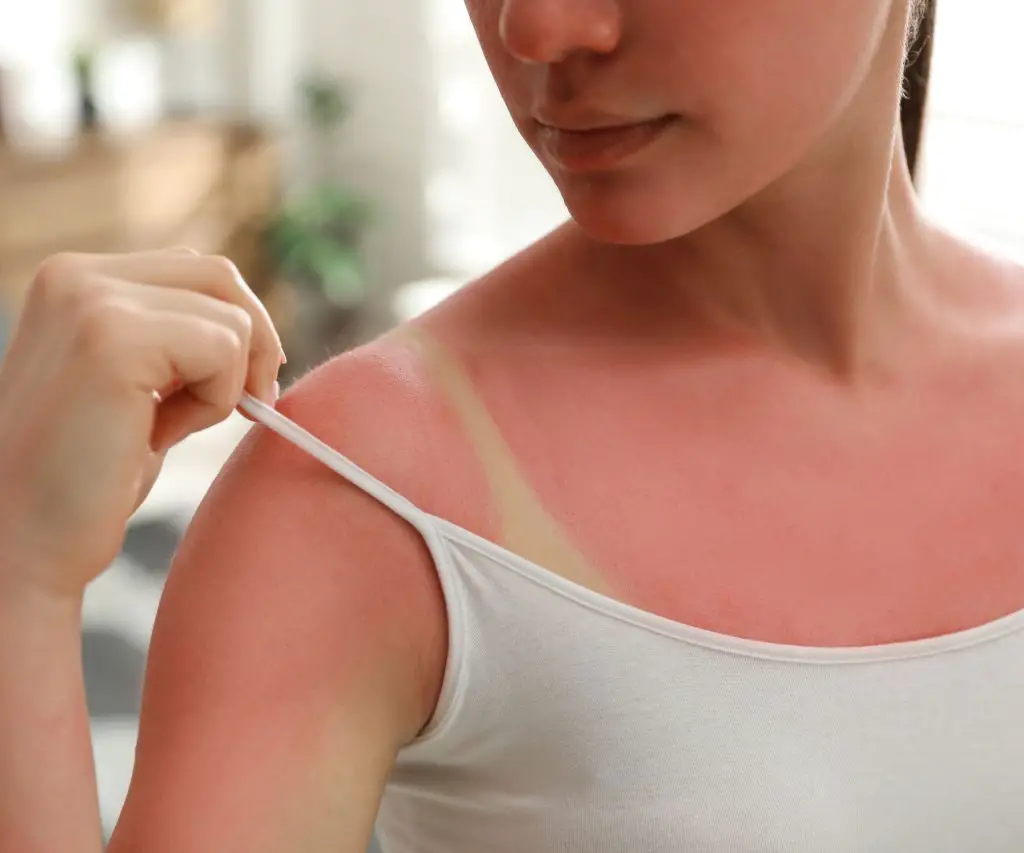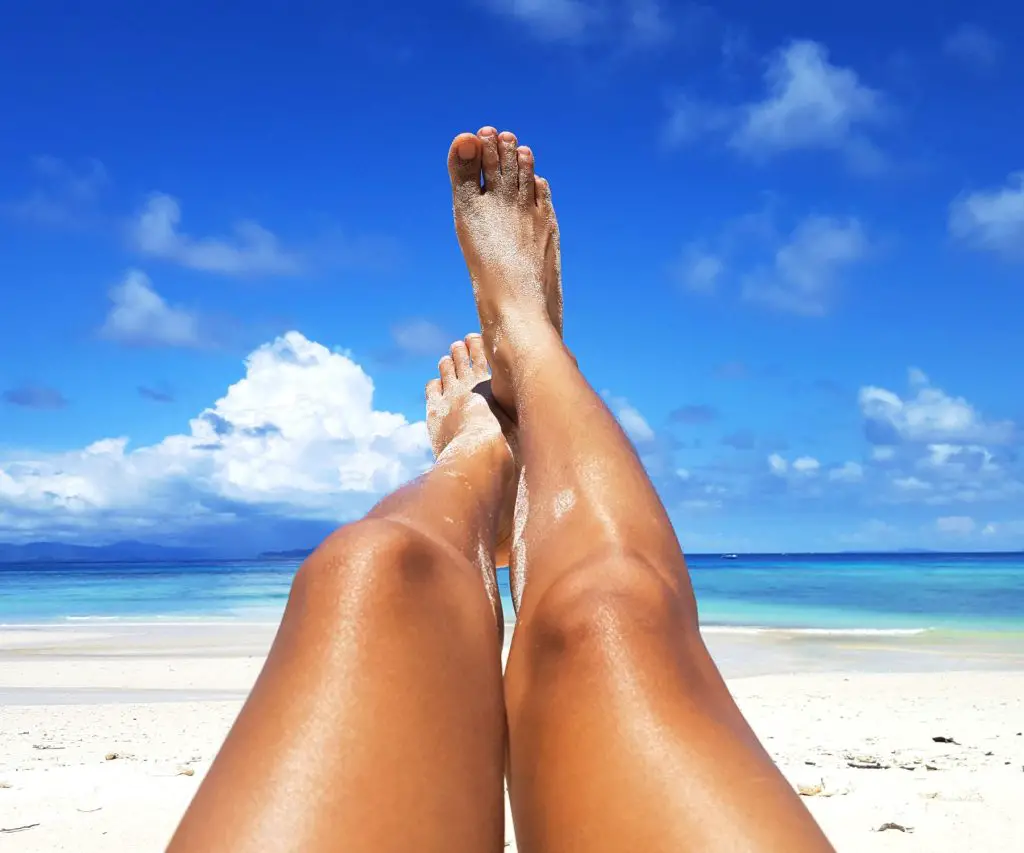Best UV Index for Tanning
 “The optimal UV index for tanning falls between 5 and 7. This level provides enough UV radiation to stimulate melanin production and allow the skin to tan relatively quickly, while limiting the likelihood of painful sunburns compared to higher index values. Tanning when the UV index is in the 5-7 range helps achieve a golden tan without putting your skin at serious risk.”
“The optimal UV index for tanning falls between 5 and 7. This level provides enough UV radiation to stimulate melanin production and allow the skin to tan relatively quickly, while limiting the likelihood of painful sunburns compared to higher index values. Tanning when the UV index is in the 5-7 range helps achieve a golden tan without putting your skin at serious risk.”
I learned this lesson the hard way this past summer when I went swimming without sunscreen, thinking I’d be safe from sunburn if I stayed underwater most of the time.
I was very wrong!
It was only about 85° outside so I wasn’t too worried about not having any sunscreen. After all I’ve been swimming multiple times throughout the summer so I was pretty used to it I thought.
But only after maybe an hour in the pool, my shoulders and back were beet red and painfully burned. It was pretty shocking how badly I was sunburned.
The water reflected sunlight onto my skin and allowed UV rays to penetrate below the surface.
It just goes to show how important the UV index is, even when you’re in the water!
Table of Contents
Introduction
The UV (ultraviolet) index is a measurement of the level of ultraviolet radiation from the sun that reaches the Earth’s surface.
The higher the UV index value, the greater the potential for skin damage from excessive exposure to the sun’s rays. When it comes to tanning safely, not all UV index values are equal.
There is an ideal range that allows the skin to tan at a moderate pace while minimizing the risks of sunburns and long-term skin damage.
What is the UV Index?
The UV index is a standardized measurement of the intensity of ultraviolet radiation from the sun, developed by the World Health Organization and other health organizations. The values range from 1 to 11+, with higher numbers indicating a greater amount of UV radiation reaching the Earth’s surface in that area.
Some key facts about the UV index scale:
- It is a linear scale, so an increase of 1 index point reflects a proportional rise in UV intensity. For example, UV index 6 has twice the radiation as UV index 3.
- The values represent UV intensity at the Earth’s surface at solar noon, when the sun is highest in the sky.
- The scale measurements focus on UVB radiation (280–315 nm), the most damaging type of UV ray.
- Indexes are tailored to the sensitivity of Caucasian skin to UV exposure. Those with darker skin may tolerate higher indexes better.
- Values under 2 indicate very low risk of harm, while indexes over 11 are considered extreme risk.
The intensity of UV radiation, and therefore the UV index value, is influenced by several factors:
- Ozone layer – Depletion of the ozone allows more UV to reach Earth. Seasonal ozone layer changes impact UV indexes.
- Time of day – Indexes peak at solar noon when sun is direct overhead. They are lower early/late in day.
- Cloud cover – More clouds=less UV penetration to surface. But some clouds don’t block UV much.
- Altitude – Higher elevation = less atmosphere to absorb UV. Indexes increase with altitude.
- Latitude – More direct sunlight and longer days means higher summer UV near the equator.
- Season – Indexes are higher in summers, lower in winters.
- Pollution/particles – Some air pollutants absorb UV radiation, reducing the UV index.
The UV index is included in many weather forecasts to help people prepare for sun safety that day. Apps and websites also provide index info by zip code so you can check your exposure risk.
How Does the UV Index Relate to Tanning?
Tanning occurs when melanin, the pigment in skin, darkens in response to exposure to ultraviolet radiation. Melanin acts as the skin’s natural sunscreen by absorbing and scattering UV rays. More melanin results in darker color that we identify as a tan.
The higher the UV index value, the more intense the UV radiation striking the skin. Therefore, higher UV indexes allow tanning to occur more quickly. The body ramps up melanin production faster under high UV exposure in an attempt to protect deeper tissues from damage.
However, there are risks to tanning with high UV indexes over 8-10:
- Greater chance of sunburns as skin reddens from radiation damage faster than melanin can respond
- Premature skin aging and wrinkling from the breakdown of collagen and elastin fibers
- Higher likelihood of developing skin cancers from accumulated DNA mutations over time
- Immune system suppression from excessive UV radiation, reducing the skin’s ability to heal
A lower UV index between 2-5 will allow tanning to occur, but more gradually over many hours of exposure. The risks of burning are greatly reduced. However, achieving a dark tan will require many repeated exposures as melanin production is slower with less intense UV light.
What is the Ideal UV Index for Tanning?
UV Index 5-7 is Optimal
An ideal UV index range for tanning falls between 5 and 7. This level of UV intensity stimulates the skin to ramp up melanin production at a moderate pace. It typically allows enough UV exposure to achieve a noticeable tan within 30-60 minutes for many skin types, without putting the skin at high risk of burns.
Some benefits of tanning with a UV index in the 5-7 range:
- Usually low enough to prevent painful sunburns during early seasonal tanning sessions.
- Results in a fairly quick cosmetic color change within a week or two of careful tanning.
- Less likely to cause long-term skin damage and cancer risks compared to higher indexes.
- Provides a good balance of UV exposure to create a tan while allowing the skin’s defenses (melanin) to respond.
- Indexes in this range occur frequently on sunny spring and summer days in most locations.
UV indexes in this “sweet spot” zone allow the skin to tan at an efficient pace while minimizing harm, especially when proper sunscreen and other precautions are used.
 Avoid UV Indexes 8-10
Avoid UV Indexes 8-10
Very high UV indexes over 8-10 can allow tanning to occur the fastest, sometimes within as little as 15-30 minutes for some skin types. However, spending long periods under these intense UV conditions puts skin at great risk of sunburns and long-term damage.
At these extreme UV levels:
- Sunburn can develop very rapidly, within 15-30 minutes for sensitive skin. Blistering burns are possible.
- High exposure is likely to accelerate skin aging, wrinkling, and mottling over time.
- The high UV radiation can damage the immune system, inhibiting the skin’s ability to heal itself.
- There is a substantially greater chance of developing skin cancer after repeated exposure at this intensity.
- Tan lines are likely to be more prominent and irregular due to skin burning.
For most skin types, the risks of tanning under UV index 8-10 conditions outweigh the benefits of slightly faster tan development. Any tan achieved is unlikely to be worth the potential for painful burns or developing skin cancer later in life. It is wise to avoid extended sun bathing above this range.
UV Index Under 5
In areas or times of day when the UV index is under 5, tanning is generally slower and requires much longer exposure to build up melanin and color over many sessions. But the upside is there is far less chance of burning, even with hours of sun exposure.
The benefits of tanning with a low UV index under 5 include:
- Greatly reduced risk of painful sunburns – Low risk even if you fall asleep in the sun!
- Very small impact on skin aging compared to higher UV.
- Low skin cancer risk from occasional exposure. Lifetime risk still increases if under sun a lot.
- Easy to tan slowly over time without burning if careful.
The downsides of trying to tan with a low UV index are:
- Can require many hours over several days/weeks to build noticeable tan.
- Difficult to achieve deep brown color; tan likely to appear light golden.
- Need to take great care not to burn if index rises day-to-day.
If you are limited to tanning only at times or locations where the UV index is very low (under 3), it is recommended to limit your overall exposure time across multiple sessions. While a single exposure probably won’t burn, cumulative exposure can increase risks if you are on the sun for hours and hours over days seeking a tan.
Tips for Tanning Based on the UV Index
Here are some tips to tan safely based on guidance from dermatologists and the EPA:
- When the UV index is in the ideal 5-7 range, start with 30-60 minute tanning sessions and gradually increase.
- Apply broad spectrum SPF 15+ sunscreen to easily burned areas like the face, shoulders and chest whenever outdoors, regardless of UV index. Reapply every 2 hours.
- Carefully monitor your skin and go inside/apply more sunscreen if you notice burning or redness. A tan takes time to build – don’t overdo it seeking instant gratification!
- Seek shade during peak UV intensity hours between 10am-4pm. Use an umbrella at the beach.
- Hydrate frequently with water and drinks high in electrolytes when out in the sun and heat.
- Check the forecasted UV index each day when planning outdoor activities or extended sunbathing sessions. Plan accordingly.
- Wear UV blocking sunglasses whenever outside to protect the delicate eye area.
- Resistance training and antioxidants may help boost skin’s defenses against UV damage from tanning.
Why You Can Still Burn Even With Sunscreen
- Even when you use sunscreen properly, it’s still possible to get burned when swimming or in other water activities. Here are some reasons why:
- Sunscreen washes off – Swimming, especially in pools, can cause sunscreen to wash off the skin quite quickly. Even “waterproof” sunscreen loses effectiveness in water over time.
- Sunscreen wasn’t reapplied – Sunscreens need to be reapplied every 2 hours when swimming to maintain protection as the ingredients break down. A single application likely wore off.
- Sunscreen wasn’t water resistant – Using a sunscreen designed to be water resistant will provide better protection while swimming versus regular sunscreens.
- Improper application – Rubbing sunscreen in thoroughly before getting in the water is key. If applied too thinly or unevenly, it won’t offer adequate protection.
- High UV index – If the UV index was very high that day, even properly applied sunscreen may not fully prevent burning without additional protection like shirts.
- Reflection from water – The reflection of UV rays off the water can overcome even high SPF sunscreens after awhile.
- You were in the sun too long – No sunscreen can prevent all burning if you’re exposed to intense sunlight for too long.
The combination of sunscreen wearing off in water, high UV levels, and extended exposure likely contributed to you still getting burned. Be sure to reapply waterproof sunscreen very frequently when swimming and limit time in the sun.
 The Takeaway
The Takeaway
For fastest tanning with the least potential risk, aim to get sun when the UV index is between 5-7. This level allows skin to tan relatively quickly while limiting likelihood of burns and long-term damage. Avoid intensive tanning when UV index is over 8-10 due to exponentially greater risks. Monitor your skin closely during EVERY tanning session and adjust exposure times based on how your skin responds. With reasonable precautions, you can achieve an attractive golden tan safely over the course of a few weeks. But a natural tan always requires a little patience – don’t burn your skin seeking quick cosmetic coloration.


 Avoid UV Indexes 8-10
Avoid UV Indexes 8-10 The Takeaway
The Takeaway